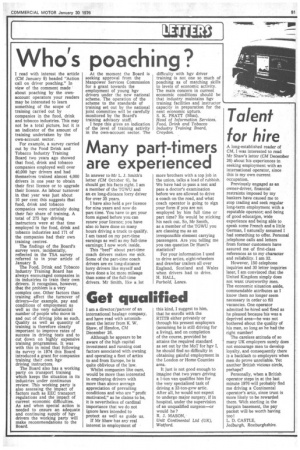Who's poaching?
Page 57

If you've noticed an error in this article please click here to report it so we can fix it.
I read with interest the article (CM January 9) headed "Action call on driver poaching." In view of the comment made ' about poaching by the ownaccount operators your readers may be interested to learn something of the scope of training carried out by companies in the food, drink and tobacco industries. This may not be a total picture, but it is an indicator of the amount of training undertaken by the own-account sector.
For example, a survey carried out by the Food Drink and Tobacco Industry Training Board two years ago showed that food, drink and tobacco companies employed well over 40,000 hgv drivers and had themselves trained almost 4,000 drivers in one year •to obtain their first licence or to upgrade their licence. As labour turnover in that year was just about 10 per tent this suggests that food, drink and tobacco companies were certainly doing their fair share of training. A total of 275 hgv driving instructors were at that time employed in the food, drink and tobacco industries and 171 of the companies had their own training centreS.
The findings of the Board's survey were, incidentally, reflected in the TSA survey referred to in your article of January 9.
The Food, Drink and Tobacco Industry Training Board has always encouraged companies in its industries to train their own drivers. It recognises, however, ,that the problem is a very complex one. Other factors than training affect the turnover of drivers—for example, pay and conditions of employment as well as the very substantial number of people who move in and out of driving jobs as such. Quality as well as quantity of training is therefore clearly important to improve rates of success in driving tests and to cut down on highly expensive training programmes. It was with this in mind that following its survey in 1974 this Board introduced a grant for companies training their own hgv
driving instructors.
The Board also has a working party on transport training which keeps the situation in its industries under continuous review. This working party is also assessing the impact of factors such as EEC transport regulations and the impact of current economic difficulties. As and when special action is needed to ensure an adequate and continuing supply of hgv drivers the working party will make recommendations to the Board. At the moment the Board is seeking approval from the Manpower Services Commission for a grant towards the employment of young hgv drivers under the new national scheme. The operation of the scheme to the standards of training set out by the national joint committee will be carefully monitored by the Board's training advisory staff.
I hope this gives an indication of the level of training activity in the own-account sector. The difficulty with hgv driver training is not one so much of poaching as of matching skills to levels of economic activity. The main concern in current economic conditions should be that industry maintains hgv training facilities .and instructor capacity in preparation for the next economic upturn.
S. K. PRATT (Miss), Head of information Services, Food, Drink and Tobacco industry Training Board, Croydon.
































































































